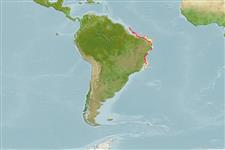Пластиножаберные (акулы и скаты) (sharks and rays) >
Squaliformes (Sleeper and dogfish sharks) >
Squalidae (Dogfish sharks)
Etymology: Squalus: Genus name from Latin 'squalus' meaning shark (Ref. 6885, 27436); albicaudus: Name from Latin 'albus' for white and 'cauda' for tail, referring to the white ventral lobe of its caudal fin..
Environment: milieu / climate zone / depth range / distribution range
экология
морской донно-пелагический; пределы глубины 195 - 421 m (Ref. 109601). Tropical
распространение
страны | регионы FAO | Ecosystems | места находок | Point map | интродукции | Faunafri
Southwest Atlantic: Brazil (between NE and SE Brazilian coast; often reported between the states of Bahia and Espírito Santo; distribution to southern Brazil is unknown).
Size / Вес / Возраст
Maturity: Lm ? range ? - ? cm
Max length : 52.5 cm TL самец/пол неопределен; (Ref. 109601); 59.0 cm TL (female)
Краткое описание
морфология | морфометрия
позвонки: 110 - 116. This species can be distinguished from its congeners by the following set of characters: caudal fin with a mostly white ventral caudal lobe, its dorsal margin white at midline, and postventral margins broadly white; posterior margin of pectoral-fin broadly white; first dorsal fin with anterior margin also conspicuously white on its anterior half; differs from all species of the S. mitsukurii group with its short snout (vs. large), pectoral-fin free rear tips pointed (vs. rounded), dermal denticles lanceolate and unicuspid (vs. rhomboid and tricuspid); differs from S. cubensis by having a snout strongly pointed (vs. somewhat rounded), second dorsal-fin spine not reaching second dorsal-fin apex (vs. spine reaching second dorsal-fin apex), first dorsal fin with dark apex, but not as a black blotch (vs. distinct black blotch on both dorsal fins), pectoral fins with posterior margin broadly white (vs. narrowly white), in external morphometrics (Squalus albicaudus has a shorter first dorsal fin, anterior margin length 10.9%, 9.7%-11.2% TL vs. 11.6%, 11.6%-12.7% TL, shorter second dorsal fin, anterior margin length 9.2%, 8.8%-10.8% TL vs. 12.3%, 11.2%-11.6% TL, inner margin length 5.0%, 4.1%-5.2% TL vs. 5.6%, 5.5%-6.0% TL, more slender second dorsal-fin spine, width at base 0.9%, 0.6%-0.9% TL vs. 1.0%, 1.0%-1.2%, and clasper much more elongated, inner margin length 7.1%, 6.9%-7.7% TL vs. 8.0%, 3.3%-3.8% TL (Ref. 109601).
Life cycle and mating behavior
половая зрелость | размножение | нерест | икра | Fecundity | личинки
Viana, S.T.d.F., M.R. De Carvalho and U.L. Gomes, 2016. Taxonomy and morphology of species of the genus Squalus Linnaeus, 1758 from the Southwestern Atlantic Ocean (Chondrichthyes: Squaliformes: Squalidae). Zootaxa 4133(1):1-89. (Ref. 109601)
Статус Красного Списка МСОП (Ref. 130435)
Угроза для людей
Harmless
Использование человеком
дополнительная информация
странырегионы FAOEcosystemsместа находокинтродукцииStocksэкологияпищапищевые объектыпотребление пищирацион
народные названиясинонимыобмен веществхищникиэкотоксикологияразмножениеполовая зрелостьнерестSpawning aggregationFecundityикраРазвитие икры
Возраст/РазмерыростЗависимость между длиной и массой телаЗависимость между длинамиРазмерный составморфометрияморфологияличинкидинамика численности личинокпополнениечисленностьBRUVS
ссылкиаквакультура (рыбоводство)особенности рыбоводствастепень растяжениягенетикаElectrophoresesнаследуемостьболезниобработкаNutrientsMass conversion
соавторыизображенияStamps, Coins Misc.звукиCiguateraскоростьтип плаванияжаберная областьOtolithsмозгзрение
инструменты
Специальные отчеты
Скачать в формате XML
ресурсы в Интернет
Estimates based on models
Phylogenetic diversity index (Ref.
82804): PD
50 = 0.5000 [Uniqueness, from 0.5 = low to 2.0 = high].
Bayesian length-weight: a=0.00933 (0.00346 - 0.02519), b=3.02 (2.79 - 3.25), in cm total length, based on LWR estimates for this (Sub)family-body shape (Ref.
93245).
Trophic level (Ref.
69278): 4.2 ±0.3 se; based on size and trophs of closest relatives
устойчивость к внешним воздействиям (Ref.
120179): низкий, минимальное время удвоения популяции 4.5-14 лет (Preliminary K or Fecundity.).
Fishing Vulnerability (Ref.
59153): Moderate vulnerability (44 of 100).
